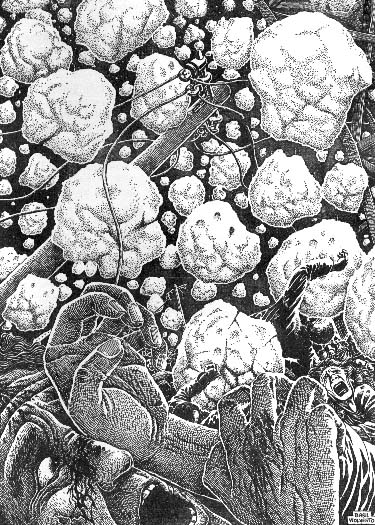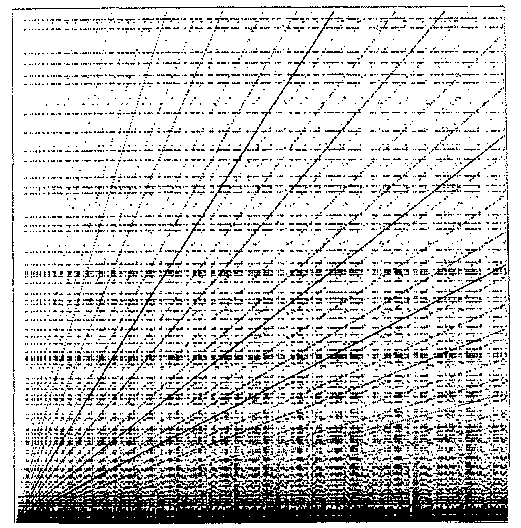Cliff Pickover's Patterns in the Mysterious Hailstone (3n+1) Numbers

|
A particularly famous problem in number theory,
the hailstone problem,
has fascinated
mathematicians for several decades.
(I love making graphics showing patterns in these numbers.)
The problem has been studied
primarily because it is so simple to state yet apparently
intractably hard to solve. This problem is
also known as the 3n+1 problem,
the Collatz algorithm, and the Syracuse problem.
The hailstone algorithm is defined by the function
h: N -> N
on the set of positive integers:
h(n) =
n/2 if n even
or
3n + 1 if n odd
where
n
is any initial positive integer.
Let
k(n)
be the kth
iterate of
h(n) .
A sequence of hailstone numbers is generated in a mathematical
feedback loop where
hk(n) = h(hk-1(n)) for k memberof N
and can be represented as
H(n) = {hk (n) } k = 1,2,3, ....
|
For example, the hailstone sequence for 3 is:
H(3) =
{ 3, 10, 5,
16, 8, 4, 2,
1, 4, ...}.
Below is H(n) vs. n.
This is a plot for a range of starting positive integers
(1 < n < 1000) on the x-axis.
The y-axis is cut off at
H(n)=1000.

|
All the strange plots in my books, such as this one, reveal a pattern of diagonal lines of
varying density which pass through the origin,
a pattern of horizontal lines (visually
reminiscent of preferred energy state diagrams in quantum mechanics)
and a diffuse "background" of chaotically positioned dots.
An interpretation of the
existence of the horizontal lines is immediate: they represent
certain values which are much commoner than others and far too common to
be explained by any statistical process. Other mathematicians have
noted preferred states in the hailstone numbers (Hayes, 1984),
and an outstanding
example is state 9,232. Of the first 1,000 integers more than 350 have
their maximum at 9,232.
|
The existence of the pronounced diagonal
lines is probably indicative of "likely" transformations which the 3n + 1
sequence naturally gives rise to. For the hailstones, we are
often multiplying by 3 and then dividing by 2.
Therefore, the linear
transformation
y = (3/2)x
is quite common (we can eliminate the + 1 in n+1 for large x).
Like hailstones falling from the sky through storm clouds,
this sequence drifts
down and up, sometimes in seemingly haphazard
patterns.
Also like hailstones, hailstone numbers always seem eventually to
fall back down to the ground (the integer 1).
In fact, it is conjectured that every hailstone
sequence ends in the cycle 4,2,1,4,...
This hailstone conjecture has been numerically checked for
a large range of
n,
and the current record has been
set by N. Yoneda who has checked all integers less than
2 40~ 1.2 * 1012
(see Legarias (1985)).
High-speed computers have allowed investigators to check the validity
of many mathematical conjectures, and various
mathematical evidence now goes into
unimaginably large numbers. However,
numerical evidence should be viewed with caution and is sometimes
inadequate. For example, consider
the fact that
integral from 2 to x of 1/ln t dt - pi (x)
is positive for all
x <= 1012
and probably far beyond
(pi(x)
is the number of prime numbers less than or equal to x)
(Wagon, 1985)).
This massive amount of evidence previously led researchers astray;
however, it
is now known that a sign change does occur, but all that is currently
known is that the first sign change occurs below
1.65 * 101165 .
A variety of cash awards have been offered for a solution to the
hailstone problem.
A number of researchers have noted that the hailstone
sequence gives rise to a mixture of regularity and disorder: it is
definitely not random, but the pattern resists interpretation. This
problem in number theory can be placed in a much larger context of chaos
theory which involves the study of a range of mathematical and physical
phenomena exhibiting a sensitive and often irregular dependence on
initial conditions.
Computer graphics is a good method by
which patterns in this hailstone sequence can be made more obvious to the
mathematician. Unfortunately, computer graphics has been little
exploited in 3n+1 work .
Watching the figures evolve dynamically upon the screen
helps to give an appreciation of the complicated behavior of
3n+1
numbers.
The
H(n)
maps clearly display preferred states, but exactly why
these states and clusters of states exist is unclear.
Every possible integer state and trajectory length (path before
returning to 1) can be produced -- but again some numbers appear more
often than others. As Paul
Erdos commented on the complexity of 3n+1
numbers, "Mathematics is not yet ready for such problems."
For more information on hailstone numbers and these hailstone number plots computed
for larger ranges, see:
Clifford Pickover, Computers, Pattern, Chaos and Beauty and
Wonders of Numbers.
Other writers and mathematicians have looked at this problem:
Legarias (1985), Wagon (1985),
Garner (1981), Crandall (1978), Hayes (1984).

